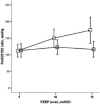Acute respiratory distress syndrome: A clinical review
- PMID: 22034606
- PMCID: PMC3198645
- DOI: 10.4103/2045-8932.83454
Acute respiratory distress syndrome: A clinical review
Abstract
The acute respiratory distress syndrome (ARDS) is a complex disorder of heterogeneous etiologies characterized by a consistent, recognizable pattern of lung injury. Extensive epidemiologic studies and clinical intervention trials have been conducted to address the high mortality of this disorder and have provided significant insight into the complexity of studying new therapies for this condition. The existing clinical investigations in ARDS will be highlighted in this review. The limitations to current definitions, patient selection, and outcome assessment will be considered. While significant attention has been focused on the parenchymal injury that characterizes this disorder and the clinical support of gas exchange function, relatively limited focus has been directed to hemodynamic and pulmonary vascular dysfunction equally prominent in the disease. The limited available clinical information in this area will also be reviewed. The current standards for cardiopulmonary management of the condition will be outlined. Current gaps in our understanding of the clinical condition will be highlighted with the expectation that continued progress will contribute to a decline in disease mortality.
Keywords: ARDS; acute cor pulmonale; acute lung injury; adult respiratory distress syndrome; clinical trial; gas exchange; hypoxia; hypoxic pulmonary vasoconstriction; positive end expiratory pressure.
Conflict of interest statement
Figures




References
-
- Rubenfeld GD, Caldwell E, Peabody E, Weaver J, Martin DP, Neff M, et al. Incidence and outcomes of acute lung injury. N Engl J Med. 2005;20(353):1685–93. - PubMed
-
- Ventilation with lower tidal volumes as compared with traditional tidal volumes for acute lung injury and the acute respiratory distress syndrome. The Acute Respiratory Distress Syndrome Network. N Engl J Med. 2000;342:1301–8. - PubMed
-
- Ashbaugh DG, Bigelow DB, Petty TL, Levine BE. Acute respiratory distress in adults. Lancet. 1967;290:319–23. - PubMed
-
- Murray JF, Matthay MA, Luce JM, Flick MR. An expanded definition of the adult respiratory distress syndrome. Am Rev Respir Dis. 1988;138:720–3. - PubMed
-
- Monchi M, Bellenfant F, Cariou A, Joly L, Thebert D, Laurent I, et al. Early predictive factors of survival in the acute respiratory distress syndrome: A multivariate analysis. Am J Respir Crit Care Med. 1998;158:1076–81. - PubMed
LinkOut - more resources
Full Text Sources
Other Literature Sources

